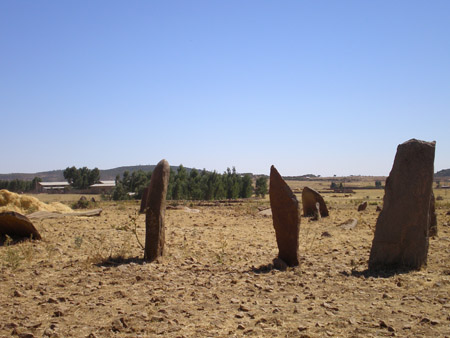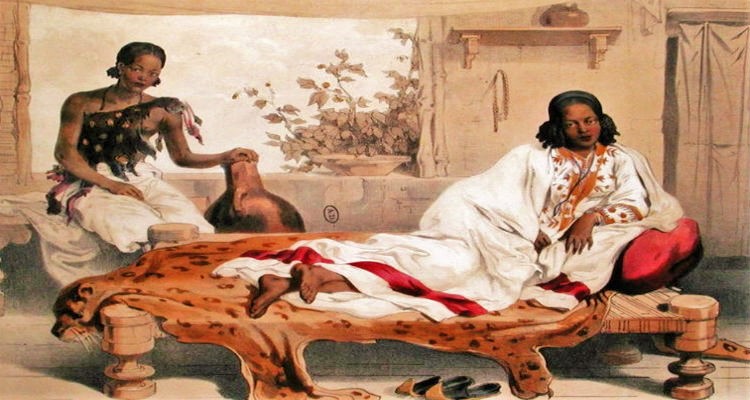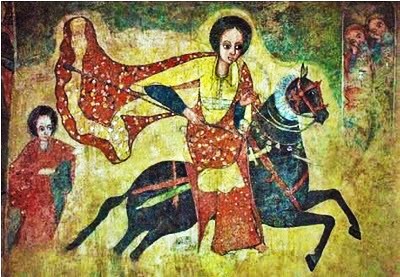The fall of the Aksumite kingdom of Ethiopia toward the end of the 10th century A.D. was attributed to a queen who invaded from the south. This queen is said to have laid waste to the city of Aksum and the countryside, destroyed churches and monuments, usurped the throne from the ruling Aksumite king, and attempted to wipe out the remaining members of the royal family. Yet, this queen is a great mystery, and opinions about her vary from one scholar to another.

Carlo Conti Rossini first proposed that the account of this warrior queen in the History of the Patriarchs of Alexandria, where she was described as Bani al-Hamwiyah, ought to be read as Bani al-Damutah, and argued that she was ruler of the once-powerful kingdom of Damot, and that she was related to one of the indigenous Sidamo peoples of southern Ethiopia. This would agree with the numerous references to matriarchs ruling the Sidamo polities.
She appears in the expansion The African Kingdoms for the HD Edition of the game Age of Empires II.
Gudit ( Judith) is a, non-Christian, Beta Israel queen (flourished c.960) who laid waste to Axum and its countryside, destroyed churches and monuments, and attempted to exterminate the members of the ruling Axumite dynasty. Her deeds are recorded in the oral tradition and mentioned incidentally in various historical accounts.
Information about Gudit is contradictory and incomplete. Paul B. Henze wrote, “She is said to have killed the emperor, ascended the throne herself, and reigned for 40 years. Accounts of her violent misdeeds are still related among peasants in the north Ethiopian countryside.”Henze continues in a footnote:

Abreha and Atsbeha Church
On my first visit to the rock church of Abreha and Atsbeha in eastern Tigray in 1970, I noticed that its intricately carved ceiling was blackened by soot. The priest explained it as the work of Gudit, who had piled the church full of hay and set it ablaze nine centuries before.
There is a tradition that Gudit sacked and burned Debre Damo, which at the time was a treasury and a prison for the male relatives of the king of Ethiopia; this may be an echo of the later capture and sack of Amba Geshen byAhmed Gragn.
If Gudit did not belong to one of the Sidamo peoples, then some scholars, based on the traditions that Gudit was Jewish, propose that she was of the Agaw people, who historically have been numerous in Lasta, and a number of whom (known as the Beta Israel), have professed an Israelite pre-Ezra Judaism since ancient times. If she was not of Hebrew, Israelite or Jewish origin, she might have been a convert to Judaism by her husband, or pagan. Local traditions around Adi Kaweh where she allegedly died and was buried indicate her faith was pagan-Hebraic,rather than Israelite or Jewish [Leeman 2009].
https://youtu.be/YApr6iQB_ZI
It was during the office of Patriarch Philotheos of Alexandria when Gudit started her revolt, near the end of the reign of the king who had deposed the Abuna Petros. As Taddesse Tamrat explains, at the time “his own death in the conflict, and the military reverses of the kingdom were taken as divine retribution for the sufferings of Abuna Petros.”

Gudit stela field, Axum, Ethiopia
This chronological synchronicity with the tenure of Patriarch Philotheos, and the intervention of king Georgios II of Makuria, provides us a date of c.960 for Gudit. A contemporary Arab historian, Ibn Hawqal, provides this account:
The country of the habasha has been ruled by a woman for many years now: she has killed the king of the habasha who was called Haḍani [from Ge’ez haṣ́ani, modern aṣ́e or atse]. Until today she rules with complete independence in her own country and the frontier areas of the country of the Haḍani, in the southern part of [the country of] the habashi.
Another historian mentions that the king of Yemen sent a zebra to the ruler of Iraq in 969/970, which he had received as a gift from the Queen of al-Habasha.
Taddesse Tamrat has speculated that one effect of Gudit’s otherwise ephemeral rule, might be the pockets of various languages related to Amharic scattered across southwestern Ethiopia (e.g. Argobba, Gurage and Gafat), which could have been Axumite military settlements isolated by her conquests and later Sidamo migrations.
Sounds like someone pissed off this woman real bad. For a woman to be angry like this, something horrible must had happened to her personaly. I don’t …and can’t even imagine who put this much hate into her heart. -Sola

More information on The Gudit of Ethiopia
Mobile University, Maker of Ethiopia, Yodit Gudit
Yodit meaning beautiful in Geez was an Ethiopian Queen of 10th century AD (about 970). Yodit some call her Judith is known for her destruction of the Axumite Empire bringing to an end the domination for over 700 years by Alexandrian Alliance on the affairs of Ethiopians. She also known as with a negative name Gudit meaning nothing having figurative connotation. And since she burned most of the monasteries of the 9 Saints that came from Byzantine or Eastern Roman Empire in Ethiopia. She was also was attributed Esato meaning fire. In Arabic writing of the time she was known as Hwyia meaning fire too. Her family originated from the Christianity resisting in the Nile provinces of Damot . Some give her being Agew and she was the first Queen of Zagwe.
Yodit young beautiful non-Christianized Hebrew girl of Axum belonging to stigmatized family that resistance to Christian conversion by Axumite evangelists. She was loved by a young deacon serving the Church of Zion where the Ark of God resides. She demanded her young lover to bring her from the church a piece of cover of the Tabot (sarcophagi) where the Ark resides as a gift for his love. Her lover did not wait to bring her the piece of the holy cloth with which she made a Shoe and a sharp. Yodit exposed herself in public with her new holy gift. Thus blaspheming the Sacred Church and the Holy artifact. She was caught and her two breasts were cut and sold as a slave to via Yemen to Damascus by the Church authorities. There she was sold to a general who fall in love with her. Her new husband was a prince known as Zenobis, son of the King of Šam. (Syria In Arabic)
Yodit came back to Ethiopia with her husband and waged a war against Axum with her Syric husband. In her first steps she hid herself in the monastery of Debre Bizen in Eritrea. To this day in the monastery female are not allowed to visit. She set out with her husband at the head of an army and attacked Aksum in vengeance for harsh treatment that she had received in the past. And established Hebrewism the religion of Sheba as a state ideology.
Unification of Ethiopia.
“As for Abyssinia, it has been ruled by a woman for many years. It is she who killed the Emperor of Abyssinia, known as the hadani and she still holds sway over her own country and the neighbouring regions of the hadani’s country in the interior of Abyssinia”.[1]
Yodit successfully destroyed the Kingdom of Axum and reigned over Ethiopia for 4 decades. “In the seventh year of the reign of the Axumite Del-Nä’ad, She established a new dynasty that continued for 3 centuries.”[2] She expanded the border of Ethiopia west and South including the provinces of Gojjam , Begemder and up unto the Sidama provinces where she is known as Ga’Ewa where the Axum never reached.
[1] sic, translation by Enrico Cerulli (RSE, III, 273); but cf. J. S. Trimingham (Islam in Ethiopia, 52) and Taddesse Tamrat (Journal of Ethiopian Studies, X, No. 1, p. 137, n. 4), after G,. Wiet Configuration de la Terre I, 56, “…in the southern part of the land of the Habesha”
Gädlä ‘Iyäsus-Mo’a
www.africaspeaks.com/reasoning/index
www.bbc.co.uk/worldservice/africa/features/storyofafrica

Age of Empires 2 HD: The African Kingdoms Yodit
Age of Empires II: The Age of Kings is a real-time strategy (RTS) video game developed by Ensemble Studios and published by Microsoft. Released in 1999 for the Microsoft Windows and Macintosh operating systems, it was the second game in the Age of Empires series. An expansion, The Conquerors, was released in 2000. A PlayStation 2 version was released by Konami in 2001, and a Nintendo DS spinoff, Age of Empires: The Age of Kings was developed by Backbone Entertainment in 2006. A Dreamcast port, by Konami, was canceled.
The Age of Kings is set in the Middle Ages and contains thirteen playable civilizations. Players aim to gather resources, which they use to build towns, create armies, and defeat their enemies. There are five historically based campaigns, which constrict the player to specialized and story-backed conditions. There are three additional single-player game modes, and multiplayer is supported. Despite using the same game engine and similarcode to its predecessor, development of The Age of Kings took a year longer than expected, forcing Ensemble Studios to release Age of Empires: The Rise of Rome in 1998 instead. The design team focused on resolving significant issues in Age of Empires, but noted on release that some problems remained.
Reception of The Age of Kings was highly positive. The significant number of new features was praised, as were the gameplay improvements. Some reviewers, however, were critical of the presentation of units—they were seen as bland and uninteresting—while others considered The Age of Kings to be too similar to its predecessor, Age of Empires. Three months after its release, two million copies of The Age of Kings had been shipped, and it topped sales charts in seven countries. The game won multiple awards and is today considered a classic of its type, having had a significant impact on future games in its genre. Both the original Age of Empires IIand the expansion pack were later released as “the Gold Edition”.
In April 2013, Age of Empires II: HD Edition was released on the Steam digital distribution platform for Windows operating systems. The HD Edition includes both the original game and the expansion The Conquerors, as well as updated graphics for high-resolution displays. It also supports user-generated content through the Steam Workshop and multiplayer games provided through the Steam servers. On August 16, 2013, Microsoft announced The Forgotten, the first new expansion in nearly 13 years and exclusive to the HD Edition. On November 5, 2015, Microsoft released another new expansion to Age of Empires II: HD Edition, The African Kingdoms.


[…] 3rd-century King Remhai, now lies shattered on the ground. Its collapse is linked by tradition to Queen Yodit, who destroyed many of Axum’s finest buildings, but scholarly opinion is that it toppled over […]
[…] trade share was captured by Arab traders of the era. The Kingdom of Aksum was finally destroyed by Gudit, and eventually the people of Aksum were forced south and their civilization declined. As the […]
[…] ৯৬০ খ্রিস্টাব্দে দামোত নগরের শাসনকর্তা ছিলেন। তিনি প্যাগান (মতভেদে ইহুদি) […]
[…] ৯৬০ খ্রিস্টাব্দে দামোত নগরের শাসনকর্তা ছিলেন। তিনি প্যাগান (মতভেদে ইহুদি) […]
[…] ৯৬০ খ্রিস্টাব্দে দামোত নগরের শাসনকর্তা ছিলেন। তিনি প্যাগান (মতভেদে ইহুদি) […]